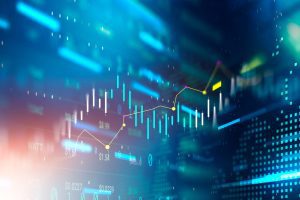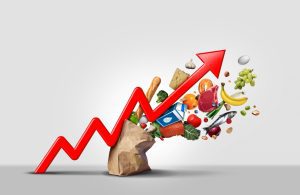This article is here to help you understand what is inflation, its underlying definition, and the multifaceted causes that set it into motion.
What Is Inflation: Definition and Causes

In the realm of economics, grasping the concept of inflation holds paramount importance. Have you ever found yourself wondering, “What is inflation?” At its heart, inflation embodies the persistent surge in the general price level of commodities and services within a given economy over a defined stretch of time.
In simpler terms, it signifies that as the years roll by, the goods we routinely purchase—such as groceries, apparel, and gasoline—tend to become progressively more costly. But have you ever pondered over the factors that propel this economic phenomenon known as inflation?
Picture a situation where suddenly, lots of kids really want a specific toy – let’s say it’s a super cool robot action figure. Every kid wants to have it, and the people who make and sell toys are struggling to make enough of them for everyone who wants one. Because there aren’t enough of these action figures to go around, their price starts going up.
This scenario precisely captures the essence of demand-pull inflation. When the demand for products and services surges beyond the economy’s supply capacity, prices invariably witness an upsurge. This phenomenon is often fueled by an array of factors, including heightened consumer spending due to a thriving economy or government-led financial injections.
Nevertheless, the rise in prices isn’t solely instigated by surging demand. There exists another facet—the cost-push inflation. Envision a scenario where the cost of fabricating those robot-themed action figures suddenly skyrockets.
This could be attributed to the escalating costs of raw materials or an augmented wage demand from the workforce involved in the assembly process. In this context, manufacturers of the action figures confront a choice: either absorb the augmented costs or transfer them to consumers through a price hike.
More often than not, the latter course of action is pursued. This exemplifies the workings of cost-push inflation. When businesses grapple with heightened production costs, they tend to elevate the prices of their merchandise to preserve profit margins.
Interestingly, it’s worth noting that inflation doesn’t invariably bear a negative connotation. A controlled, moderate degree of inflation is deemed normal within a progressing economy. It serves as a gauge of consumer expenditure, entrepreneurial profitability, and overall economic stability. Yet, when inflation spirals out of control, dire consequences can unfurl.
Consider this analogy: if the costs of everyday essentials incessantly soar, the purchasing power of your currency wanes significantly. In essence, the identical sum of money wouldn’t stretch as far as it used to. This fluctuation is evident when you stroll through supermarket aisles or refuel your vehicle. This is precisely why central banks, the regulatory bastions of a nation’s economy, vigilantly monitor and manage inflation.
So, how do central banks exercise control over inflation? They wield instruments such as interest rates. Whenever inflation embarks on an upward trajectory, central banks might opt to heighten interest rates. This, in turn, amplifies the cost of borrowing funds.
Consequently, individuals and businesses display a reduced inclination towards procuring loans for substantial expenditures, thereby contributing to the suppression of demand and inflation containment.
Conversely, when an economy faces a slump, central banks might contemplate a reduction in interest rates. This maneuver stimulates borrowing and spending, thereby invigorating demand and safeguarding the economy against the looming specter of deflation—a scenario wherein prices experience a downward spiral, thereby triggering an entirely distinct set of economic woes.
In closing, inflation, at its core, signifies the sustained elevation in the general price level of commodities and services as time progresses. This surge can be ascribed to amplified demand or escalating production costs. While a certain degree of inflation is intrinsic to a functioning economy, rampant or unpredictable inflation can precipitate unfavorable repercussions.
It impinges upon the purchasing prowess of money and jeopardizes economic stability. This is precisely why central banks occupy a pivotal role in managing inflation through mechanisms such as interest rates.
In your daily life, comprehending inflation empowers you to make informed decisions about your purchases and investments. The next time you encounter the query, “What is inflation?” you can confidently demystify it as the driving force behind the incremental cost of your beloved treats during each shopping expedition.
Measuring Inflation: Key Indicators and Indices

In the world of economics, one of the most frequently asked questions is, you guessed it, “what is inflation?” Well, to comprehend the intricate mechanisms of this economic phenomenon, it’s crucial to understand how economists measure it. So, let’s dive into the realm of measuring inflation without further ado.
At its core, inflation refers to the gradual increase in the general price level of goods and services within an economy over a certain period. So, you might be pondering, what is inflation and how do we measure it accurately? That’s where the experts step in, armed with an arsenal of indicators and indices.
Consumer Price Index (CPI):
Now, you might wonder, what is inflation and how do we keep track of it? Enter the Consumer Price Index, or as we fondly call it, the CPI. This nifty tool is like a shopping cart brimming with various goods and services an average household might purchase.
These items encompass everything from toothpaste to housing rent. By scrutinizing fluctuations in the prices of these items over time, economists can discern the rate at which inflation is creeping in.
Suppose, for a moment, that the price of oranges, coffee, and cooking oil spikes remarkably within a year. This upward price dance would inevitably find its way into the CPI, raising alarms about potential inflation. So, the CPI answers our persistent query – what is inflation, and how is it affecting the costs of our everyday necessities?
Producer Price Index (PPI):
But wait, there’s more to the story. While the CPI speaks from the perspective of the consumer, the Producer Price Index, or PPI, offers insights from the producer’s vantage point. It tracks alterations in the prices of goods and services at the wholesale level – before they reach your shopping cart.
This index’s significance lies in the fact that shifts in production costs often reverberate through the supply chain, ultimately influencing consumer prices.
Imagine a scenario where the cost of cotton, steel, and electricity used in making shirts surges dramatically. This domino effect would lead to a surge in the cost of producing shirts, compelling manufacturers to tweak their prices. The PPI serves as an early bird’s warning about potential price upheavals.
Core Inflation vs. Headline Inflation:
Now, let’s untangle the enigma of “core inflation” and “headline inflation.” These terms might sound perplexing, but fear not – they’re quite simple. Headline inflation takes into account the big picture – the overall price adjustments across all categories of goods and services.
However, it can be a bit wild due to factors like abrupt leaps in energy prices or unexpected shifts in international trade dynamics.
On the flip side, core inflation hones in on the essentials, excluding these erratic elements. This refined approach offers a more stable gauge. It presents us with insights into underlying inflation trends, untainted by transient jitters. Core inflation is akin to the steady heartbeat of inflation, stripped of momentary fluctuations.
The Significance of Precise Measurement
Now that we’ve answered the question, “what is inflation,” you might wonder why accurate measurement matters. Well, let’s dive into it. Accurate inflation measurement is pivotal for myriad reasons. For starters, it equips governments and central banks to craft apt monetary policies.
If inflation is galloping ahead, central banks might hike interest rates to rein in excessive spending and quell price surges. Conversely, if inflation is slumbering, they might slash rates to pep up economic activity.
Secondly, inflation measurement arms individuals and businesses to make prudent financial decisions. If they sense towering inflation on the horizon, they might tweak their investment strategies or pricing tactics. Moreover, fixed incomes, like pensions or bonds, can wobble under inflation’s weight.
The question “what is inflation” is just the tip of the iceberg. Delve a bit deeper, and you’ll unearth the Consumer Price Index and the Producer Price Index, the dynamic duo of inflation measurement.
These indices decode the price puzzle, guiding governments, businesses, and individuals toward informed choices. So, the next time you hear the term “inflation,” you’ll grasp that it’s not merely about soaring prices; it’s about the meticulous dance of numbers, illuminating the financial path ahead.
Inflation’s Profound Effects on the Economy and Individuals

In economics very few phenomena affect the economy as the way inflation does. Imagine walking into your favorite bakery, expecting to buy your usual morning pastry and coffee for a set amount, only to find the prices have surged. This everyday scenario illustrates the essence of inflation – the gradual but persistent increase in the overall cost of goods and services. But what is inflation, and how does it ripple through our lives, affecting both the economy and us as individuals?
At its core, inflation can be likened to a hidden tax, stealthily eroding the value of your hard-earned money. As prices rise, the purchasing power of the dollar in your pocket dwindles. This purchasing power erosion is a fundamental impact of inflation that touches everyone, from the bustling metropolis to the quiet countryside.
When inflation is left unchecked, the dollars you have today won’t stretch as far tomorrow, leading to the disconcerting realization that the savings you’ve diligently set aside might not be enough to cover future expenses.
This ripple effect becomes even more apparent in the realms of borrowing and lending. Think of a scenario where you lent a friend money with the expectation of being repaid in a year. If inflation rears its head, the value of that repayment diminishes, meaning you’re effectively losing out.
Conversely, if you’re the borrower, inflation could work in your favor, allowing you to pay back the loan with dollars that have less value than when you initially borrowed. This seesaw dance between borrowers and lenders underscores how inflation reshuffles the financial deck.
The macroeconomic consequences are equally profound. Central banks, often the guardians of economic stability, grapple with the task of maintaining inflation at a level that neither stifles nor runs rampant.
A moderate level of inflation, typically targeted around 2-3%, is considered healthy for an economy. It lubricates the wheels of commerce, giving businesses room to adjust prices and wages while incentivizing consumers to spend rather than hoard.
Yet, too much inflation can trigger economic instability. Hyperinflation, an extreme manifestation of this, can wreak havoc by rendering money nearly worthless. Remember those images from history books, where people carted stacks of currency just to buy a loaf of bread? That’s the devastating power of unchecked hyperinflation.
On the other end of the spectrum, deflation, the opposite of inflation, where prices continuously drop, might sound like a boon for consumers, but it can lead to reduced spending, hampering economic growth.
Governments also feel the reverberations of inflation. As prices rise, they must contend with increased costs for public services, salaries, and more. This often results in a delicate balancing act – increasing taxes to cover the expanding expenses, potentially angering citizens, or decreasing spending, which might hinder economic development.
The ripple effects extend to global trade as well. If a country experiences higher inflation than its trading partners, its exports could become more expensive, potentially denting international competitiveness.
Furthermore, inflation doesn’t uniformly affect everyone. It can exacerbate wealth disparities. Imagine an individual with a fixed income, such as a pensioner or someone living off interest from savings accounts.
As prices surge, their fixed income might struggle to keep pace, making it harder to maintain their standard of living. Conversely, those with assets like real estate, stocks, or commodities might find their values rising with inflation, potentially widening the wealth gap.
Conclusion
In conclusion, the enigma of inflation is far from a mere economic abstraction. It’s a powerful force that weaves through our daily lives, influencing the cost of our morning coffee, the value of our wages, and the trajectory of our economy.
From the microcosm of personal budgeting to the macrocosm of national economies, inflation’s impacts are palpable and complex.
Balancing its effects, maintaining stable growth, and ensuring that its corrosive power is harnessed within bounds remain a constant challenge for governments, central banks, and individuals alike.
So, the next time you reach for your wallet and wonder why prices seem to be inching ever upwards, remember, what you’re witnessing is the intricate dance of inflation shaping our financial world.


